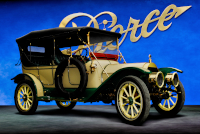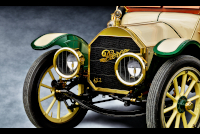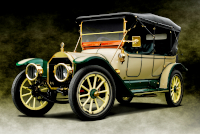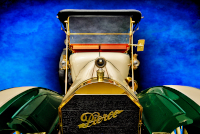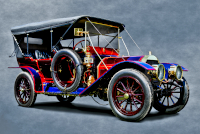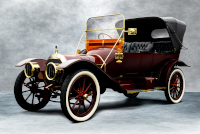Location:
St. Michaels Concours d'Elegance, 2011
Owner: Bill Alley | Greensboro, Vermont
Prologue:
Some older perspectives here, but dusky light works perfectly to create a strobe-filled studio effect. Thank E for a couple chopped perspectives and the singular Pierce nameplate that provides the background for our main studio image. Reviving this small set of photographs proved a lot of fun, with results I expected would turn out vibrant. For no better reason than the colors, I like this Pierce-Arrow. The owner, Mr. Alley, well known for his care of brass era cars, wandered close around the car as we passed by and chatted with others. Over the years we've seen a fair number of his automobiles, two of which join this portfolio—the 1912 Model 36-UU and 1906 Model 28-32NN Great Arrow.
- - - - - - - - - -
► Image Source: Nikon D200 (10.2 MP) | Image Source 2 and 4 by E., illustration by the author. Photo 2 canvas finished at 11 MP.
References:
- Ralston, Marc. "Pierce-Arrow" A.S. Barnes & Co., Inc., San Diego, CA. 1980, page 64-65, 231
- Ralston, Marc. "Pierce-Arrow, The Golden Age" Jostens Publications, Clarksville, TE. 1984, page 33, 52
Just about complete, Pierce-Arrow's steady evolution leads to the 1912 model. Door are now standard. With doors, ventilation moves to louvres in the wooden bulkhead, as first used in 1911, as well as by means of a fold-down windscreen. But the car also takes mechanical steps toward modernization. Headlamps remain acetylene, but electricity powers a rear combination oil and electric lamp, the dashboard lights, and the horn. The dash display includes fuel tank level and pressure, as well as an odometer. The motor can be operated on two ignition systems, a jump spark and master vibrator, or a Bosch high-tension magneto.
At the starting end of the range, the 36-UU depicted here is a nicely proportioned example of a period touring car, and a particularly fine example considering this is a Pierce-Arrow. The body is cast aluminum, a process specific to the marque, and the drivetrain over-built with more alloy components than common for the time. Four-speed transmission further sets the Pierce-Arrow's performance well above average, somewhat in contrast to the car's conservative appearance. The Pierce-Arrow resembles many others, but none is its equal.
To qualify hyperbole, beginning no later than 1905, Pierce undertook extraordinary quality control measures, subjecting every motor to multiple dynamometer tests, disassemblies, internal inspections, rolling chassis dynamometer tests, and road tests. Coachwork, paint, and final adjustments did not appear until the factory had proved that the mechanical components would not break. By the close of the second decade, this test process will become downright maniacal.
To conclude, chief engineer David Fergusson considers the Pierce-Arrow blueprint well established by 1910. The following years will refine the concept to completion. Doors, yes, but in the early 20th century some components aren't so highly valued. The touring car concept itself depends on enjoying the elements, so features such as integrated air compressors for tyre repair and fledgling electric systems came into development before the driver (likely a hired lad) ever needed a door of his own. In this respect, doors for the front seats indicate owners are beginning to drive automobile themselves, rather than hire out the responsibility.
Motor: 4,916 cc (300 cubic inch) straight 6-cylinder in three cast iron blocks | 101.6 mm x 130.175 mm (4" x 5⅛")
Valvetrain: T-head, single-plug
Power: 36 rated hp @ 1,700 rpm
Drivetrain: floor-shift, four-speed selective sliding-gear manual transmission, rear-wheel drive
Front Suspension: I-beam axle, semi-elliptic leaf springs, Truffault-Hartford friction shock absorbers
Rear Suspension: torsion rods, three-quarter elliptic leaf springs, Truffault-Hartford friction shock absorbers
Architecture: cast-alloy body on pressed manganese steel frame
Kerb Weight: 1,746.3 kg (3,850 lbs)
Wheelbase: 3,175 mm (125 inches)
Etymology:
The 'UU' designation follows an odd alphanumeric system that began in 1901. Pierce developed the Model 30-U from 1908 to 1909, of which few seem to have survived. The 'U' likely followed in succession after 'Q,' 'S', and 'T' had been assigned to other platforms in the same production series. The subsequent development of the Model 36 brought about the revised 'UU' designation to replace the Model 30-U, doubling the letter as was Pierce-Arrow custom. In the present day, the Model 36-UU is prevalent, so one naturally wonders where the 'UU' came from for want of knowing (or ever seeing) a Model 30-U. We therefore assume the sequence makes sense in full, and that the alphanumeric designations match a chronology known by the engineers at the factory. But the sequence is difficult to follow without a comprehensive data sheet. And for that matter, Pierce-Arrow skipped the letter 'R.'
The five-passenger touring car fit between four and six-passenger Touring models.
Figures:
In 1912, Pierce-Arrow built 1,000 units of the Model 36-UU.
Double-Bound: Updated Binding on the 1912 Pierce-Arrow
Coachwork on the 1912 Pierce-Arrow uses double-line moulding along the shoulder. Compare this 1912 Model 36-UU Touring with the 1910 Model 48-SS Touring or 1911 Model 36-UU Miniature Tonneau. We have gained a style element. Also new is the single centerline moulding strip on the bulkhead and decorative moulding on the inner fenders.
Touring or Tonneau: Identification According to Bulkhead Design
Note that the bulkhead—the transition between the front of the body and the bonnet where the windscreen attaches—is broad and somewhat flat compared to the tonneau body, which is rounded. This difference holds true for most model years. The degree of pitch and curve varies among tonneau cars.
Driver Advantages: Two Simple Features for the Modern Driver in 1912
Our images show both windscreen vents open. With doors added to all models for 1912, fresh air vents through slats in the wooden windscreen frame. The windscreen glass also folds in half.
Pierce-Arrow also used detachable rims throughout the brass era, first the Firestone type seen on 1910 models in this portfolio, and later the demountable Johnson patent type rims as on this 1912 model.
On Liveries: Herbert M. Dawley and the Pierce-Arrow Art Department
Those old proverbial history books speak about Herbert M. Dawley's contribution to Pierce-Arrow. Dawley's team selected paint and cabin combinations, insisting that a Pierce-Arrow demonstrate taste and pizzazz. The later is a technical term for early 20th century ornament. No high-end motorcar should look drab, and coachbuilders for marques as vaunted as Delaunay-Belleville and Rolls-Royce offered design-minded options similar to an interior decorator's portfolio.
In this spirit, Dawley and his team consulted with new purchasers to create liveries to their liking, while also leaning toward palettes that sought harmony in contrast. Pierce-Arrow often paired warm and cool colors, often with hand-painted details. I do not know whether the porcelain-quality maize and pine green livery of this Model 36-UU is original or a later predilection, but the combination is proper for the marque. Fine red pinstripes frame the doors, body, and bonnet, as well as the wheels and hubs—not quite visible at first, but a touch that spells refinement.
Last Updated: Mar 26, 2025

